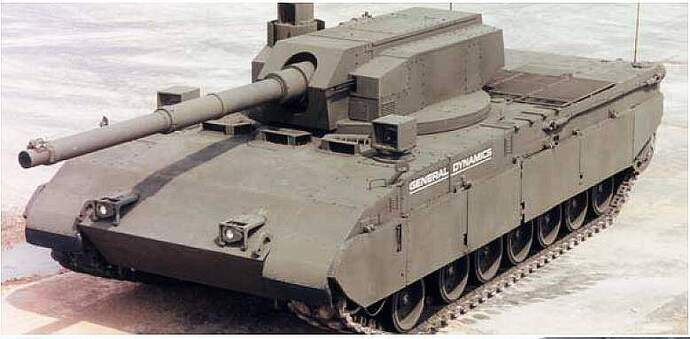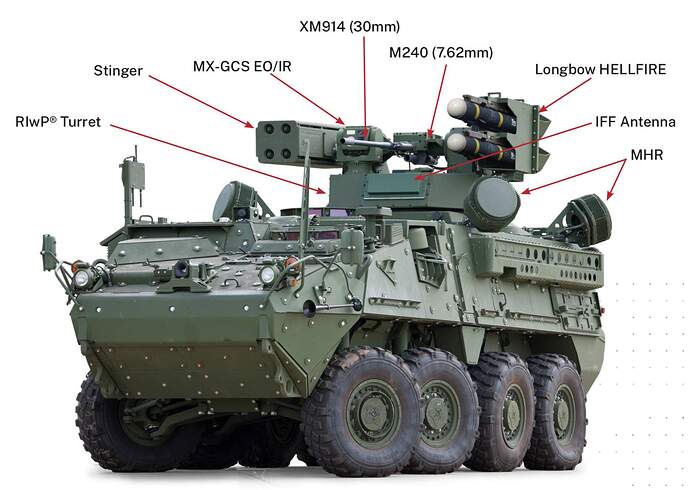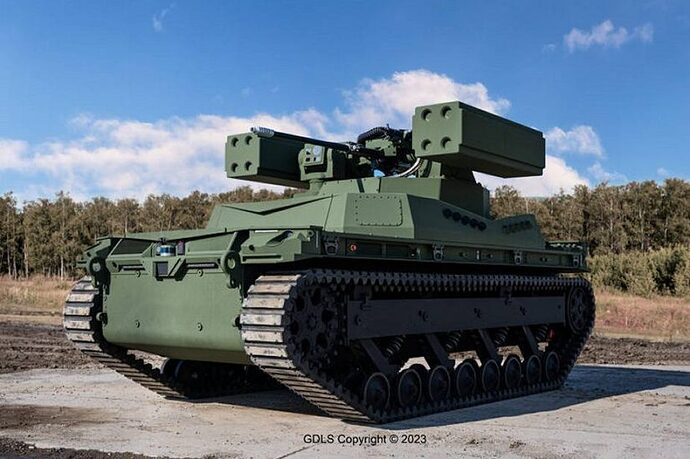EVERY tank made is “vulnerable to top down attacks”. None were designed with shields, and the Ukrainians are hardening them just as show for their Leopards.
The Abrams TTB from 1986 was a relatively serious attempt at crew-in-hull.
We have this one on Fort Moore at the Armor & Cavalry Collection.
It went well past drawings, but the decline of the Soviet Union lulled all the world into backing away from that revolution. IIRC, the Soviets developed an Ob’jkt w/ the crew in hull during the 70s.
Correct. AFVs will need a “Hard kill” kinetic system or a C-UAS jammer to extend their envelope of perimeter bubble protection beyond their turret roof armor.
The slat, gate, grill, and mesh armor is a low-tech and cheap way to provide armor protection to the turret at some stand-off distance. If it’s effective is another matter.
The AbramsX may have other countermeasures under its turret armor, but General Dynamics has remained vague about that. If the AbramsX turret is modular and allows for payloads, plug-ins, and upgrades is unknown. The four loitering munitions launchers can be replaced with C-UAS drone systems and other drones in the tubes for example.
HK APS is already being mounted to several hundred US M1A2 SEP v3. I also spoke to attendees at the reveal of the AbramsX who indicated that the turret has radar and ports for HK. The transfer to the to-be manufactured M1E3 is identified on Fort Moore (US Army tank central) as critical.
Radar is most likely the best way to detect aerial drones, and with a 30mm autocannon firing airbursting shells, a near miss can still bring down many fragile FPV cheap drones.
Also, radar with hit-to-kill projectiles can hopefully protect the AbramsX against loitering munitions.
“Radar” is a bit of an overstatement. The APS systems do use a radar system, and the AbramsX was shown with Trophy VPS. VPS is the latest version of Trophy APS. The VPS has several AESA radar antennae, several launchers, and autoloader for fast recovery. In addition there are at least four Switchblade launchers. The M230LF chain gun can be be slaved to the radars. Against volleys of ATGMs (a Hezbllah TTP)., the system was successful >95% of the time. According to observers, the tests were in sophisticated ambush and shoot alleys, not soccer pitches. ( source: Jr, Sydney J. Freedberg (March 9, 2021). “Trophy VPS For Stryker: Half The Weight, All The Protection?” Breaking Defense).
To date, Hamas FPVs w/ grenades have damaged a few IDF AFVs.
Here’s my caution: RADAR is a nebulous term generic . The VPS radar is VERY short range. So, maneuver units (MBTs, IFVs, SPGs, etc.) will still need good SHORAD systems such as the new Stryker package (M-SHORAD) in formation. These vehciles have additional electrical generation, longer acquisition and reaction timeframes, and can hard-kill a drone or loitering muntion out to about 3km. Trophy is an FPF (final protective fire): a last resort. At 95% effectiveness, I’ll take it.
FWIW- fielded ops have shown that the Longbow Hellfire rails need strengthening. So let it be done.
M-SHORAD has been fielding:
As an old tanker, the war in Ukraine has definitely shown the world a glimpse of what warfare of the future might look like. We now see on social media the unprecedented use of cheap and effective drones, capable of taking out tanks. But there’s so much to consider as to why drones have been so effective and what can be done in the future to reduce this threat.
What I understand is this. Tanks were never really effective at defending against aerial threats. And basically were never really designed for this role. Sure! Many tanks have been armed with some type of “anti-aircraft” machine gun, but history has shown us that there has been a fleeting few engagements in which a tank successfully shot down a plane or helicopter.
Yes! Your typical Tank Commander doesn’t have the situational awareness of the air space above, especially when buttoned up, but even if the tank is equipped with the means to see aerial threats, the TC is going to be busy with his normal ground based duties, which is probably going to consume all his time, already. And we don’t want to overburden the TC and his crew by giving them more to deal with.
IMO, The best hope to defend tanks against aerial threats is to develop or improve existing systems which are specific to that role, be it an AFV specifically designed to address drones and other airborne threats, from the ground, or from the air via aircraft designed to down drones and other airborne threats.
What we are seeing with how the Ukrainians and Russians are using tanks is not how the U.S and other allies use their tanks. In the U.S, a tank does not go out by itself. It operates as part of a combined arms team, with infantry, artillery, and air support. Where the tank crew has very limited visibility, the infantry around the tank often provides the eyes. In Ukraine, there is little cooridinated combined arms, between different elements. So often times, the infantry isn’t looking out for the tanks. Tanks on both sides are often sent out piecemeal and alone, making them vulnerable to drones, artillery and missile strikes.
Ed
Well said, Ed, well said.
There are several Air Defense UGVs available that may help such as the General Dynamics Land Systems TRX SHORAD below.
There is a smaller SHORAD system on a SMET, I believe, split into one SMET with radar and the other with 30mm, but I can’t seem to find it on the internet at the moment.
I don’t know if the Ukrainians and Russians are using their tanks wrong. They may have decided that using armor in mass was too expensive in losses. If a few drones can wipe out a column in minutes then don’t mass the tanks. We will see where this goes.
Hey Top, I’m not saying they are using their tanks “wrong”, but that when “we” use tanks, we use them as part of a combined arms team. We can say with certainty and history is a testament to this, that tanks don’t work too well when they are alone, and this is what we are seeing in this war.
Heres an interesting question. What if America was fighting a similar type of war? How would we address drone strikes against tanks? My guess would be, we would commit them in a combined arms team, using infantry, and artillery under full air superiority. I suspect that, since most of the small, cheap battery operated drones do not have long range communications and diminished flight time due to their payload, their operators are somewhere close to their targets. This is where infantry and artillery comes in handy. In a way this isn’t much different than having infantry ferret out and eliminate anti-tank teams using shoulder fired anti-tank weapons in urban warfare.
I think’s combined arms is the most effective means to fight such wars and we aren’t seeing this on either side in the war in Ukraine.
Ed
If the US were to fight a similar Ukrainian drone war, I think that the US Army would mount counter-drone jammers on its AFVs, just like counter-IED jammers. It would be an add-on kit attuned to jam certain frequencies. Then come the Active Protection System (APS) kits to deal with RPGs, ATGMs, and aerial drones. Nonetheless, the cost to counter drones will cost more than the drone itself.
Many military analysts and C-UAS (counter-unmanned aerial system) experts say that kinetic “hard kill” is the only want to deal with aerial drones, meaning that bullets and missiles, not jammers and electronic warfare, is the surest way to bring down a drone. But as we’ve seen with the Red Sea, firing guided missiles at aerial kamikaze drones and missiles can be very costly indeed until the navy warship (US or allied) runs out of surface-to-air missiles to fire. Thus, a bullet is the cheapest way to bring down a battlefield drone, and the US is acquiring such C-UAS turrets for dedicated C-UAS JLTVs and Strykers that combine 30mm autocannon, 7.62mm COAX medium machine gun, and two-eight Stinger missiles. And the US also is purchasing jammers too, but that doesn’t protect the tank itself which does not have these C-UAS systems unless outfitted with APS.
I still think the drone killer will end up being sonic weapons. Not as weather-prone as lasers, maybe a little less energy used and doesn’t leave any debris aside from the target. Also useful against human targets and can be dialed down to stun instead of just kill.
I must admit I’ve only skipped through most of this; however, it just reinforces to me how prescient the Soviet designer Morozov was way back in the mid 70s when he designed his Object 450 - which I’m currently building in 1:35. I know Russia has Armata around today but with secondary weapons of 30mm calibre coming almost the norm all this struck a strong chord as I progressed my build,
Morozov’s initiative resulted in the crew in the hull, a 125mm main armament (130mm planned), a 30mm secondary plus 2 x 7.62mm MGs. Not bad seeing that it was conceived around 50 years ago!
Staying on the theme of my earlier response, tanks are not really well suited to take on aerial threats. Sure, they could benefit from protective measures mounted to the tank, like anti-drone jammers. But if the next generation of tanks are to be designed to actually engage enemy aerial threats, specifically drones, IMO takes away the MBT’s vital and traditional role on the ground. I would rather see the deployment of an AFV whose role is specifically designed to deal with drone threats, being deployed alongside tanks. (Such as the TRX SHORAD shown above)
I also think that low tech ideas have value too. In the combined arms strategy, each element supports the other. The small battery powered commercial drones which much of the threat to tanks is based upon, has disadvantages. Namely, the drone operator has to be nearby his intended target. The classic combined arms strategy is to send out your infantry to ferret out threats to your tanks. They may have to go out further to find enemy drone operators, but it’s just one of the ways the drone threat can be diminished. Throw in battlefield surveillance and artillery support, and combined arms could deny hiding places where a drone operator could hide.
Edro


